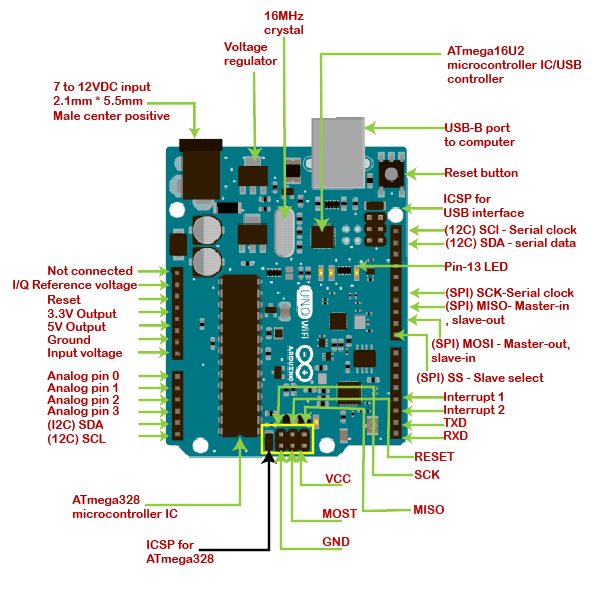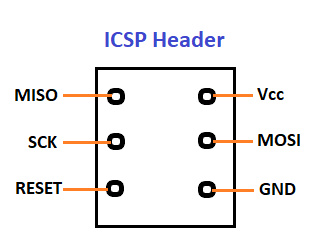Uno R3 Compatible with Arduino Without USB Cable


Digital and Analog I/O: The board comes with a set of digital input/output pins and analog input pins that allow you to interface with sensors, actuators, and other external devices.
USB Connectivity: The Arduino Uno R3 has a built-in USB interface that allows you to program the board and communicate with your computer. You can upload your Arduino sketches (code) through the USB cable.
Power Supply: The board can be powered via USB or an external power supply. It also has a voltage regulator that provides a stable 5V supply for your components.
Reset Button: The Uno R3 has a reset button that you can use to restart your program or put the board into programming mode.
Compatibility: The Uno R3 is fully compatible with the Arduino IDE (Integrated Development Environment), which is the software used to write and upload code to the board.
The "Cable for Uno R3" that you mentioned is likely a USB A-B cable. This cable connects your Arduino Uno R3 to your computer's USB port, allowing you to program the board and transfer data back and forth.
Using the Uno R3 board with the Arduino IDE is quite straightforward. You write your code in the IDE, select the board type as "Arduino Uno R3," choose the correct COM port (which represents the connected Uno R3), and then click the "Upload" button to transfer your code to the board.
The Uno R3 is an excellent choice for beginners and experienced makers alike due to its ease of use, vast community support, and availability of various shields and modules that extend its capabilities.
Prototyping: The Arduino Uno R3 board is often used as a prototyping platform to test and develop electronic circuits and systems before creating more permanent solutions.
Learning and Education: It's an excellent tool for learning electronics and programming. Beginners can start with basic projects and gradually move on to more advanced concepts.
Voltage Regulator:The voltage regulator converts the input voltage to 5V. The primary function of the voltage regulator is to regulate the voltage level in the arduino uno board. For any changes in the input voltage of the regulator, the output voltage is constant and steady.
GND - Ground pins. The ground pins are used to ground the circuit.
TXD and RXD: TXD and RXD pins are used for serial communication. The TXD is used for transmitting the data, and RXD is used for receiving the data. It also represents the successful flow of data.
USB Interface: The USB Interface is used to plug in the USB cable. It allows the board to connect to the computer. It is essential for the programming of the Arduino UNO board.
RESET: It is used to add a Reset button to the connection.
SCK: It stands for Serial Clock. These are the clock pulses, which are used to synchronize the transmission of data.
MISO: It stands for Master Input/ Slave Output. The save line in the MISO pin is used to send the data to the master.
VCC: It is the modulated DC supply voltage, which is used to regulate the ICs used in the connection. It is also called the primary voltage for ICs present on the Arduino board. The Vcc voltage value can be negative or positive with respect to the GND pin.
Crystal Oscillator: The Crystal oscillator has a frequency of 16MHz, which makes the Arduino UNO a powerful board.
ICSP: It stands for In-Circuit Serial Programming. The users can program the Arduino board's firmware using the ICSP pins. The program or firmware with advanced functionalities is received by the microcontroller with the help of the ICSP header. The ICSP header consists of 6 pins.
SCL: It stands for Serial Clock. It is defined as the line that carries the clock data. It is used to synchronize the transfer of data between the two devices. The Serial Clock is generated by the device and it is called as master.
SPI: It stands for Serial Peripheral Interface. It is popularly used by microcontrollers to communicate with one or more peripheral devices quickly. It uses conductors for data receiving, data sending, synchronization, and device selection (for communication).
MOSI : It stands for Master Output/ Slave Input. The MOSI and SCK are driven by the Master.
SS: It stands for Slave Select. It is the Slave Select line, which is used by the master. It acts as the enable line.
I2C : It is the two-wire serial communication protocol. It stands for Inter-Integrated Circuits. The I2C is a serial communication protocol that uses SCL (Serial Clock) and SDA (Serial Data) to receive and send data between two devices. 3.3V and 5V are the operating voltages of the board.
Uno R3 Compatible with Arduino Without USB Cable
Available:In Stock
- Product SKU: KG026
₹ 449
₹ 599
Need Volume Discounts? Deals are specially designed for you. Click here
Need Customization? Provide us more details Click here
🏠
Warehouse Details:


Specification
Description
Arduino Uno R3 is a popular microcontroller board that is fully compatible with Arduino. It is one of the most commonly used boards for prototyping and creating various electronic projects.
Key Features of the Arduino Uno R3:
Microcontroller: The Arduino Uno R3 is based on the ATmega328P microcontroller, which is the main processing unit responsible for running your Arduino code.Digital and Analog I/O: The board comes with a set of digital input/output pins and analog input pins that allow you to interface with sensors, actuators, and other external devices.
USB Connectivity: The Arduino Uno R3 has a built-in USB interface that allows you to program the board and communicate with your computer. You can upload your Arduino sketches (code) through the USB cable.
Power Supply: The board can be powered via USB or an external power supply. It also has a voltage regulator that provides a stable 5V supply for your components.
Reset Button: The Uno R3 has a reset button that you can use to restart your program or put the board into programming mode.
Compatibility: The Uno R3 is fully compatible with the Arduino IDE (Integrated Development Environment), which is the software used to write and upload code to the board.
The "Cable for Uno R3" that you mentioned is likely a USB A-B cable. This cable connects your Arduino Uno R3 to your computer's USB port, allowing you to program the board and transfer data back and forth.
Using the Uno R3 board with the Arduino IDE is quite straightforward. You write your code in the IDE, select the board type as "Arduino Uno R3," choose the correct COM port (which represents the connected Uno R3), and then click the "Upload" button to transfer your code to the board.
The Uno R3 is an excellent choice for beginners and experienced makers alike due to its ease of use, vast community support, and availability of various shields and modules that extend its capabilities.
Applications of Arduino Uno Board :
Microcontroller Projects:The Arduino Uno R3 Compatible board is versatile and can be used for a wide variety of microcontroller projects, from simple LED blinking experiments to complex IoT (Internet of Things) applications.Prototyping: The Arduino Uno R3 board is often used as a prototyping platform to test and develop electronic circuits and systems before creating more permanent solutions.
Learning and Education: It's an excellent tool for learning electronics and programming. Beginners can start with basic projects and gradually move on to more advanced concepts.
Pinout Diagram of Arduino Uno Board

Pin Configuration of Arduino Uno Board
ATmega328 Microcontroller:It is a single-chip Microcontroller of the ATmel family. The processor core inside it is 8-bit. It is a low-cost, low-powered, and simple microcontroller. The arduino uno board and Nano models are based on the ATmega328 Microcontroller.Voltage Regulator:The voltage regulator converts the input voltage to 5V. The primary function of the voltage regulator is to regulate the voltage level in the arduino uno board. For any changes in the input voltage of the regulator, the output voltage is constant and steady.
GND - Ground pins. The ground pins are used to ground the circuit.
TXD and RXD: TXD and RXD pins are used for serial communication. The TXD is used for transmitting the data, and RXD is used for receiving the data. It also represents the successful flow of data.
USB Interface: The USB Interface is used to plug in the USB cable. It allows the board to connect to the computer. It is essential for the programming of the Arduino UNO board.
RESET: It is used to add a Reset button to the connection.
SCK: It stands for Serial Clock. These are the clock pulses, which are used to synchronize the transmission of data.
MISO: It stands for Master Input/ Slave Output. The save line in the MISO pin is used to send the data to the master.
VCC: It is the modulated DC supply voltage, which is used to regulate the ICs used in the connection. It is also called the primary voltage for ICs present on the Arduino board. The Vcc voltage value can be negative or positive with respect to the GND pin.
Crystal Oscillator: The Crystal oscillator has a frequency of 16MHz, which makes the Arduino UNO a powerful board.
ICSP: It stands for In-Circuit Serial Programming. The users can program the Arduino board's firmware using the ICSP pins. The program or firmware with advanced functionalities is received by the microcontroller with the help of the ICSP header. The ICSP header consists of 6 pins.
The Arduino Uno R3 structure of the ICSP header is shown below:

SCL: It stands for Serial Clock. It is defined as the line that carries the clock data. It is used to synchronize the transfer of data between the two devices. The Serial Clock is generated by the device and it is called as master.
SPI: It stands for Serial Peripheral Interface. It is popularly used by microcontrollers to communicate with one or more peripheral devices quickly. It uses conductors for data receiving, data sending, synchronization, and device selection (for communication).
MOSI : It stands for Master Output/ Slave Input. The MOSI and SCK are driven by the Master.
SS: It stands for Slave Select. It is the Slave Select line, which is used by the master. It acts as the enable line.
I2C : It is the two-wire serial communication protocol. It stands for Inter-Integrated Circuits. The I2C is a serial communication protocol that uses SCL (Serial Clock) and SDA (Serial Data) to receive and send data between two devices. 3.3V and 5V are the operating voltages of the board.
Technical Details of Arduino Uno Board
- Model Type : Arduino Uno R3
- Cable is not included with the model
- Microcontroller Chip: ATmega328
- Operating Voltage (VDC): 5
- Input Voltage(Recommended) : 7-12V
- Input Voltage (limit) : 6-20V
- Analog I/O Pins: 6
- Digital I/O Pins: 14 (of which 6 provide PWM output)
- PWM Digital I/O Pins: 6
- DC Current for 3.3V Pin (mA): 50
- DC Current per I/O Pin (mA) : 40
- Clock Speed: 16 MHz
- SRAM: 2
- EEPROM: 1 KB (ATmega328)
- Flash Memory: 32 KB
- On-Board LEDs: On/Off, L (PIN 13), TX, RX
Physical Attributes of Arduino Uno Board
- Length * Width * Height (mm) : 75 x 54 x 12
- Weight (gm): 27
UNO R3 CH340G :
- Model Type: UNO Rev R3
- Microcontroller Chip: ATmega328
- Color: Blue
- Input Voltage(Recommended): 7-12V
- Input Voltage (limit): 6-20V
- Operating Voltage: 5
- Analog I/O Pins: 6
- Digital I/O Pins: 14 (of which 6 provide PWM output)
- PWM Digital I/O Pins: 6
- DC Current per I/O Pin: DC Current per I/O Pin: 40 mA; DC Current for 3.3V Pin: 50 mA
- Clock Speed: 16 MHz
- EEPROM: 1 KB (ATmega328)
- Flash Memory: 32 KB (ATmega328) of which 0.5 KB is used by the bootloader
- PWM Output Pins: 6
- SRAM: 2 KB (ATmega328)
- Power Supply Option: DC Jack or USB
- Operating Temperature (°C): -40 to +90
- Dimensions in mm (LxWxH): 75 x 54 x 12
- Weight (gm): 26
Product Video
Let’s start coding now!!!!
- Useful links Arduino Guide
Package Includes
- 1 x Uno R3 Compatible with Arduino Without USB Cable







































